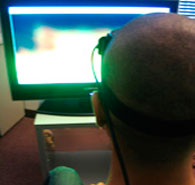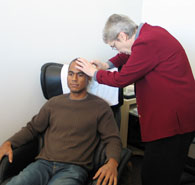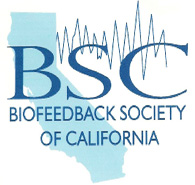Archive for the ‘Research’ Category
Monday, June 18th, 2007
 The Applied Neuroscience Conference was held in Nijmegen, the Netherlands, from May 17-20. I imagine that for many the experience was as singular and as epochal as the first Winter Brain Conference in Key West was for us in 1993. The Society for Applied Neuroscience chose not to have a conference every year, on the grounds that there would not be sufficient new material to justify the effort! But in response to this planned hiatus an ad-hoc organization formed to put on this conference in The Netherlands, which may well have the highest density of neurofeedback practitioners anywhere in the world. The Applied Neuroscience Conference was held in Nijmegen, the Netherlands, from May 17-20. I imagine that for many the experience was as singular and as epochal as the first Winter Brain Conference in Key West was for us in 1993. The Society for Applied Neuroscience chose not to have a conference every year, on the grounds that there would not be sufficient new material to justify the effort! But in response to this planned hiatus an ad-hoc organization formed to put on this conference in The Netherlands, which may well have the highest density of neurofeedback practitioners anywhere in the world.
There were some 220 attendees, with 21 nationalities represented, of which 50% were from Holland. Appropriately, the conference was held in Nijmegen, where some 23% of the working population is concerned with either health care or education. It is also a very healthy place to live. The dominant form of transport in this university town is the bicycle. I estimated that there were some 1300 bicycles parked at the train station in dedicated space. One did not see obesity prominently anywhere. (more…)
Posted in Conferences, Neurofeedback, Research | No Comments »
Thursday, March 1st, 2007
 The new pIR3 is a passive infrared sensor device for biofeedback. Three infrared sensors are mounted in the plastic housing that sits on the forehead and is attached with an adjustable band around the head. Since we are looking at signals from left, right and center, it is important to place the device appropriately so that the label is right side up and the cable extends from the right side of the device. The infrared sensors are not in contact with the forehead, but are held at some distance away so they can measure heat that is radiated from the head. It is important to seat the housing securely (stably) just above the eyebrows. If any hair falls between the forehead and sensors, the signal will be diminished and also more variable, so care must be taken to move any hair out of the way. The new pIR3 is a passive infrared sensor device for biofeedback. Three infrared sensors are mounted in the plastic housing that sits on the forehead and is attached with an adjustable band around the head. Since we are looking at signals from left, right and center, it is important to place the device appropriately so that the label is right side up and the cable extends from the right side of the device. The infrared sensors are not in contact with the forehead, but are held at some distance away so they can measure heat that is radiated from the head. It is important to seat the housing securely (stably) just above the eyebrows. If any hair falls between the forehead and sensors, the signal will be diminished and also more variable, so care must be taken to move any hair out of the way.
The pIR3 follows the lead of Jeff Carmen, who has worked extensively with pIR HEG biofeedback, primarily for migraine headaches. Jeff’s work has used a single sensor for feedback, which is typically placed at Fpz. The pIR3 provides three sensors at approximately Fp1, Fpz and Fp2, and hence the ability to combine the signals as desired for feedback purposes. The pIR3 plugs into any of the three peripheral device inputs on the front of the Neuroamp. BioExplorer software displays the signals and Particle Editor provides additional feedback information and reward. (more…)
Posted in Biofeedback, Hardware Related, PIR / NIR, Research, Software Related | 1 Comment »
Thursday, February 8th, 2007
 The individualization of training has had a long history in neurofeedback. It began perhaps with Joel Lubar’s choosing whether to reinforce the standard SMR band of 12-15Hz or the low-beta band of 15-18 Hz, or whether to do both in pursuit of different objectives in work with ADD/ADHD children. At our hands, it eventually became a matter of choosing whether a person should train “SMR” at C4 or “beta” at C3, or perhaps a mixture of both. There seemed to be a general tendency toward lower-frequency training at the right hemisphere. We were able to address hemisphere-specific function in a more optimized way, and we could modulate arousal level more flexibly with the two available choices. The individualization of training has had a long history in neurofeedback. It began perhaps with Joel Lubar’s choosing whether to reinforce the standard SMR band of 12-15Hz or the low-beta band of 15-18 Hz, or whether to do both in pursuit of different objectives in work with ADD/ADHD children. At our hands, it eventually became a matter of choosing whether a person should train “SMR” at C4 or “beta” at C3, or perhaps a mixture of both. There seemed to be a general tendency toward lower-frequency training at the right hemisphere. We were able to address hemisphere-specific function in a more optimized way, and we could modulate arousal level more flexibly with the two available choices.
The two standard bands had both been given currency by Barry Sterman’s early work, and we took them as a given. The SMR band acquired a kind of usage validity over time, and the beta band could be considered a vernier. Margaret Ayers used the beta band almost exclusively in those early days, principally for working with head injury, and for her the SMR band was the vernier. The beta band was for nudging the under-aroused head-injured and ADD people (the Satterfield model) into better functionality, and the SMR band was for general calming of over-arousal. (more…)
Posted in Clinical, Neurofeedback, Research | No Comments »
Thursday, January 4th, 2007
 It was my hope that the Biofeedback Society of California Annual Conference would offer a favorable climate for the cross-fertilization between peripheral and EEG biofeedback that now badly needs to occur. In actual fact, the rather large program made for considerable fragmentation and splintering of the audience, as nearly everyone gravitated to their own traditional priorities. Tribalism won out again, an opportunity lost. Sue and I were almost the only ones who actually addressed the main topic of evidence-based practice, but nevertheless our audience was mainly neurofeedback people. It was my hope that the Biofeedback Society of California Annual Conference would offer a favorable climate for the cross-fertilization between peripheral and EEG biofeedback that now badly needs to occur. In actual fact, the rather large program made for considerable fragmentation and splintering of the audience, as nearly everyone gravitated to their own traditional priorities. Tribalism won out again, an opportunity lost. Sue and I were almost the only ones who actually addressed the main topic of evidence-based practice, but nevertheless our audience was mainly neurofeedback people.
The program did, however, offer some real gems that have broad implications for healthcare. Robert Gorter, MD, who is both Associate Professor at the UCSF School of Medicine and head of oncology research at a Berlin hospital, talked of new perspectives in cancer research. Gorter is also involved with anthroposophical medicine in Europe, which attempts to practice more naturalistically and comprehensively. The thrust in cancer research is toward strategies of immunomodulation, with cancer largely seen as an immune deficiency condition. Our immune systems are conducting a perpetual campaign against tumor formation. That is the steady state. When that process fails, boosting the immune system should be invoked as a remedy. (more…)
Posted in Biofeedback, Conferences, Neurofeedback, Research | No Comments »
Thursday, October 12th, 2006
In his editorial, “The Reality and the Promise”, Siegfried Othmer discussed the NIH’s lack of interest in supporting neurofeedback research. The NIH’s failure to pursue investigations into a treatment modality as clearly valuable and underutilized as neurofeedback reflects a larger evolving crisis in biomedical research. The psychiatrist and editor of Medical Hypotheses Bruce Charlton argues that, “it is unlikely that current patterns of medical science funding will yield the hoped-for advances in therapeutics that provide the main justification for expanding the input of resources. Too much expansion, too narrowly channeled, for too long, has probably led to increasing inefficiency, with diminishing returns from ever-greater spending.”Consider, for example, the three largest NIH grants awarded in 2005:
- $53 million to MIT to “Generate high quality genome sequence”
- $46 million to Washington University to “Improve informatics tools, produce genome sequence”
- $33 million to Baylor College of Medicine to “Produce draft sequences of the rhesus macaque and bovine genomes”
(more…)
Posted in Research | No Comments »
Thursday, August 31st, 2006
The Quietmind Foundation Institutional Review Board There’s been a great deal of discussion taking place of late among practitioners at all levels in the field seeking clarity on the basic science behind various models of neurofeedback training. Within this discussion there are many calls for ‘where’s the data?’ The most notable critiques of neurofeedback refer to the paucity of class 1 research that involves randomized double-blind designs with substantive sample sizes conducted by non-practitioners. Many views are being promoting about the underlying mechanisms of action that determine the functional and behavioral changes we see every day in our consulting rooms, agencies, schools and homes where neurofeedback is employed. These unanswered questions reverberate in the critiques from other disciplines that expect to see peer-reviewed studies involving large samples with randomized controlled designs as convincing evidence of clinical efficacy.
The Quietmind Foundation has chosen to respond to this situation by creating a specialized Institutional Review Board (QMFIRB) to support relevant, safe and ethical independent research efforts within the field by neurofeedback professionals who are not affiliated with a university or agency with its own IRB. All major journals especially in the health and neurosciences require IRB approval before they will consider a study for publication. This lack of IRB approval may have prevented important information about the efficacy of neurofeedback from reaching the broader professional community. (more…)
Posted in Neurofeedback, Research | No Comments »
|
|
Subscribe to Email Newsletter
The EEG Info Newsletter circulates via email at least once a month. A variety of topics related to the Neurofeedback / EEG Biofeedback field are covered in over 200 articles.
|
 The Applied Neuroscience Conference was held in Nijmegen, the Netherlands, from May 17-20. I imagine that for many the experience was as singular and as epochal as the first Winter Brain Conference in Key West was for us in 1993. The Society for Applied Neuroscience chose not to have a conference every year, on the grounds that there would not be sufficient new material to justify the effort! But in response to this planned hiatus an ad-hoc organization formed to put on this conference in The Netherlands, which may well have the highest density of neurofeedback practitioners anywhere in the world.
The Applied Neuroscience Conference was held in Nijmegen, the Netherlands, from May 17-20. I imagine that for many the experience was as singular and as epochal as the first Winter Brain Conference in Key West was for us in 1993. The Society for Applied Neuroscience chose not to have a conference every year, on the grounds that there would not be sufficient new material to justify the effort! But in response to this planned hiatus an ad-hoc organization formed to put on this conference in The Netherlands, which may well have the highest density of neurofeedback practitioners anywhere in the world.
 The new pIR3 is a passive infrared sensor device for biofeedback. Three infrared sensors are mounted in the plastic housing that sits on the forehead and is attached with an adjustable band around the head. Since we are looking at signals from left, right and center, it is important to place the device appropriately so that the label is right side up and the cable extends from the right side of the device. The infrared sensors are not in contact with the forehead, but are held at some distance away so they can measure heat that is radiated from the head. It is important to seat the housing securely (stably) just above the eyebrows. If any hair falls between the forehead and sensors, the signal will be diminished and also more variable, so care must be taken to move any hair out of the way.
The new pIR3 is a passive infrared sensor device for biofeedback. Three infrared sensors are mounted in the plastic housing that sits on the forehead and is attached with an adjustable band around the head. Since we are looking at signals from left, right and center, it is important to place the device appropriately so that the label is right side up and the cable extends from the right side of the device. The infrared sensors are not in contact with the forehead, but are held at some distance away so they can measure heat that is radiated from the head. It is important to seat the housing securely (stably) just above the eyebrows. If any hair falls between the forehead and sensors, the signal will be diminished and also more variable, so care must be taken to move any hair out of the way. The individualization of training has had a long history in neurofeedback. It began perhaps with Joel Lubar’s choosing whether to reinforce the standard SMR band of 12-15Hz or the low-beta band of 15-18 Hz, or whether to do both in pursuit of different objectives in work with ADD/ADHD children. At our hands, it eventually became a matter of choosing whether a person should train “SMR” at C4 or “beta” at C3, or perhaps a mixture of both. There seemed to be a general tendency toward lower-frequency training at the right hemisphere. We were able to address hemisphere-specific function in a more optimized way, and we could modulate arousal level more flexibly with the two available choices.
The individualization of training has had a long history in neurofeedback. It began perhaps with Joel Lubar’s choosing whether to reinforce the standard SMR band of 12-15Hz or the low-beta band of 15-18 Hz, or whether to do both in pursuit of different objectives in work with ADD/ADHD children. At our hands, it eventually became a matter of choosing whether a person should train “SMR” at C4 or “beta” at C3, or perhaps a mixture of both. There seemed to be a general tendency toward lower-frequency training at the right hemisphere. We were able to address hemisphere-specific function in a more optimized way, and we could modulate arousal level more flexibly with the two available choices. It was my hope that the Biofeedback Society of California Annual Conference would offer a favorable climate for the cross-fertilization between peripheral and EEG biofeedback that now badly needs to occur. In actual fact, the rather large program made for considerable fragmentation and splintering of the audience, as nearly everyone gravitated to their own traditional priorities. Tribalism won out again, an opportunity lost. Sue and I were almost the only ones who actually addressed the main topic of evidence-based practice, but nevertheless our audience was mainly neurofeedback people.
It was my hope that the Biofeedback Society of California Annual Conference would offer a favorable climate for the cross-fertilization between peripheral and EEG biofeedback that now badly needs to occur. In actual fact, the rather large program made for considerable fragmentation and splintering of the audience, as nearly everyone gravitated to their own traditional priorities. Tribalism won out again, an opportunity lost. Sue and I were almost the only ones who actually addressed the main topic of evidence-based practice, but nevertheless our audience was mainly neurofeedback people.